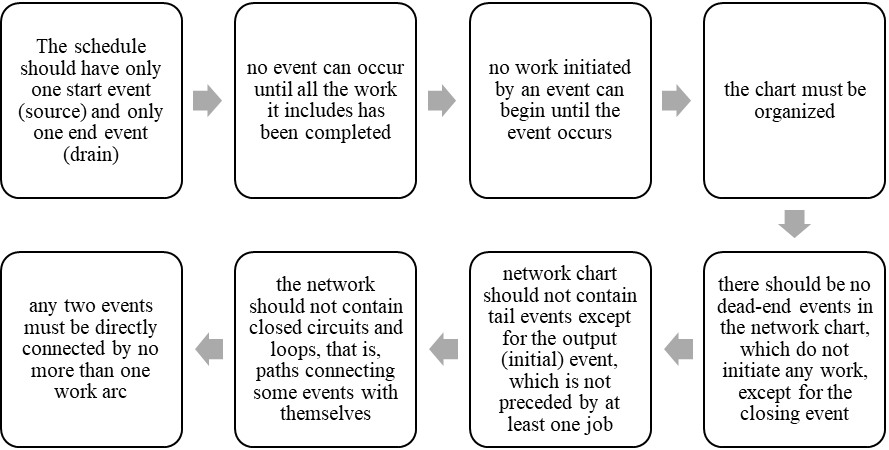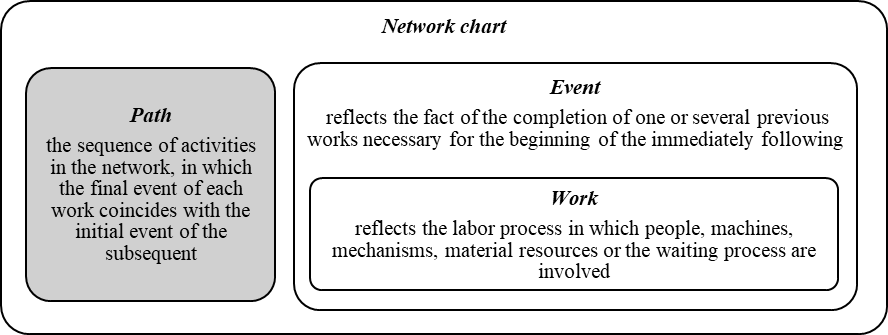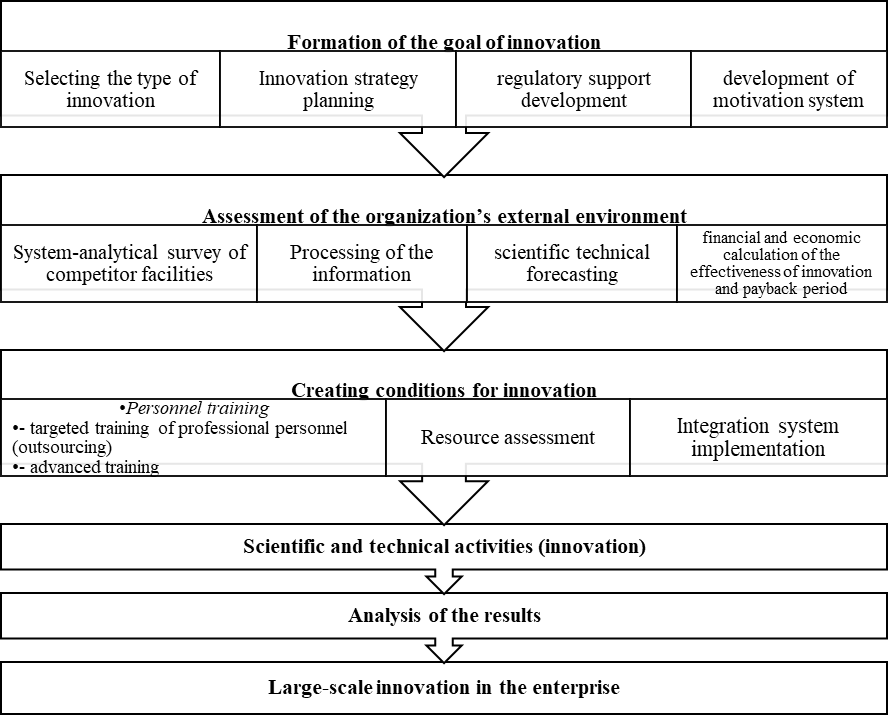Abstract
Modern development of any industry is impossible without introduction and application of innovations and innovative technological solutions, since the level of activation of the latter determines the overall level of competitiveness. Innovative behavior is the prerequisite for the implementation of various market strategies by business entities aimed at achieving advantages due to the compulsory anticipation of competitors in the subject, technological, organizational and / or management areas and achieved through the implementation of creative entrepreneurial decisions. Enterprises with an innovative type of behavior implement a whole range of scientific, technical, technological, organizational, financial and commercial activities, which together lead to the emergence of various types of innovations. The implementation of digital technologies is multidimensional. One of the priorities is network planning, which is a set of graphical and computational methods, organizational measures and control techniques that provide modeling, analysis, and dynamic restructuring of the plan for the implementation of work packages and developments. Network graphics allow creating a project that has visibility, the ability to identify technological links between operations, graphical representation of critical paths, the definition of overall deadlines for the work and their optimization. The article examines the use of the network planning and management system in the agro-industrial complex as one of the ways to visualize innovative processes, describes modern software products designed to solve project management tasks, develops a system of project objectives for introducing innovative type of competitive behavior in an agro-industrial complex (AIC).
Keywords: Agriculturedigital technologiesinnovationnetwork chartprojectvisualization
Introduction
Many researchers have confirmed that competitiveness of products is a fundamental factor that provides the necessary level of competitiveness of an enterprise. Of course, it is the central, but not the only activator of achieving competitive advantages. The world practice of the development of branches of the agro-industrial complex shows that innovative behavior of economic entities of the agro-industrial complex contributes to the organizational, technological, technical and economic renewal of agricultural production and increase its competitiveness (Getmanchuk, 2011). Innovative type of competitive behavior is the focused nature of action of a business entity based on the application of various innovations, both on technical, production, economic, organizational, managerial, informational and social levels (Yurina & Grishakina, 2015). Innovative processes in agriculture have their own specific features. They are distinguished by a variety of regional, sectoral, functional, technological and organizational features. Today, there are quite a few approaches for classifying innovations (Golova, 2015; Golova & Sukhovey, 2018; Dankevich, 2012; Ivanov, 2012; Kuptsov, 2007; Qingrui et al., 2007). The opinions of scientists regarding the classification of innovations in the field of agriculture are also of great interest. So, some authors highlight:
material and technical innovations that are aimed at the technical improvement of the production of agricultural products;
technological innovations that contribute to the updating and improvement of engineering, agronomic, computer, resource-saving and high-tech production technologies, storage and processing of products;
innovation in breeding - the creation, updating and improvement of the composition of seeds;
organizational and information - managerial, based on changing and improving the organizational structure, technics and methods of planning and managing production activities, information and infrastructure support of the agricultural sector;
marketing, representing changes and improvements in the management and regulation of sales activities;
socio-economic and environmental innovations that are focused on the transformation and improvement of working conditions in production, social security of the team, development of a system of training and advanced training of personnel, preservation of the ecology in agro-industrial production, as well as the production of environmentally friendly products.
Problem Statement
The implementation of a certain type or the set of innovations should be carried out in accordance with an innovative project. The project will be the sequence of work pursuing a deterministic goal, performed at a specified time, by specially appointed employees within the framework of the established estimate. An innovative project is considered to be a set of documents that define a system of scientifically grounded goals and measures to solve a problem, the organization of innovation processes in space and time (Minnikhanov, Alekseev, Faizrakhmanov, & Sagdiev, 2003).
An innovative project is developed considering the planned innovative behavior and goals that a business entity determines according by an innovative strategy - improving the quality of the goods produced; price reduction without changing product's characteristics; reducing the cost of goods produced by the development of new technologies, methods of organization of production, labor and management; an increase in the production of goods (sales) for the same market without changing other parameters; development of a new market for an old or new product.
Research Questions
1.What is an innovative project?
2.How is an innovative project being implemented through visualization technologies, in particular, through the network chart?
3.What are the objectives of the project of introducing an innovative type of competitive behavior in an enterprise in the AIC sector?
Purpose of the Study
The purpose of the study is to describe the structure of network planning and modern software products, i.e. visualization tools designed to solve project management tasks, and develop a system of project objectives for introducing innovative types of competitive behavior in an agro-industrial complex enterprise.
Research Methods
The authors used the following methods: monographic, comparative and system analysis, as well as logical approach.
Findings
In our opinion, the optimal project that takes into account the production and technological, scientific and technical, financial and economic and personnel innovation potential of the enterprise is a project consisting of four main stages (Figure

Project planning can be viewed as a procedure that takes place in a few steps.
1. Identification of goals and objectives, definition of restrictions on the project.
2. Fragmentation of the total volume of the project into smaller tasks, their differentiation. A task is a technological operation, event, type of activity or a combination of them, characterized by time spent on execution, the need for resources and the conditions under which they can be performed.
3. Network plan development, where the duration of the tasks and their interrelationships are established, the schedule is debugged using the critical path method, the project time is calculated.
4. Forming a list of required resources, their volume and period of use. Resources should be divided into non-stored and stored in an innovative project. The first ones are released upon completion of the work and are suitable for their subsequent use (for example, employees of the enterprise (specialists), technical equipment, computers and software, etc.). The second group includes resources that are fully spent in the process of the project. These are all kinds of materials: fertilizer, fuel, seeds, etc. Resources manager distributes the described resources between tasks (according to the goals).
5. Preparation of estimates containing value for all types of costs (Chekaldin, 2017; Shimanovskaya, 2014).
In the current business environment it is necessary to develop a model that is understandable, dynamic and, at the same time, powerful enough to allow analysis of influencing factors in order to effectively implement an innovative project, control and complete it. Its existence will make it possible to determine the minimum possible project implementation time under specified conditions and, finding a critical path (chain of related works completed in time), indicate a subset of critical works (processes forming a critical path), even the smallest delay of which will lead to a delay in the end of the project. Thanks to this, the project manager can prevent interruptions by concentrating resources on the most critical areas.
The dynamic model of the project, which presents the technical possibility of visualizing the processes within the project and reflects the technological dependence and sequence of the work package, linking their completion in time, considering the cost of resources and cost of work while highlighting the critical places is the network chart. Network charts are used to plan all kinds of long-term processes; coordinating the actions of project managers and implementers; calculation of the required production, including material and labor resources and their rational exploitation. The developer should consider the following rules in the network chart (Figure

The network chart structure is shown in Figure

Production processes reflected with the help of chart-schedules was first used by G. Rentier in American firms (Belyaev, 2011).
Competent network planning in the conditions of modern business and production activities helps to achieve more efficient implementation of research and development, contributes to the modernization and repair of technological equipment, allows getting the maximum possible effect from experimental development, launching mass production, etc. (Belyaev, 2011; Romanova, 2017).
During the implementation of network planning, the operational and strategic objectives presented in the table
A lot of methods of planning and management are developed based on network models. The most famous among them is the so-called critical path method (CPM – Critical Path Method), as well as a system for planning and managing development programs (PERT – Program Evaluation and Review Technique).
The modern Russian market of information technologies (IT) is represented by a large number of software products using PERT technology, designed to solve project management tasks. All of these software products can be divided into two groups, namely, programs designed to automate services such as ARTA Software (ARTA Synergy), Epicor Software, IFS Applications, Microsoft Project Professional, Oracle E-Business Suite, PeopleSoft Project Management, Primavera, SAP Professional Services Automation), and software products aimed at managing tasks and projects. The latter include software products such as: Bontq, Cerebro, Easy Projects. NET, eGroupWare, GanttProject, Kommandcore, OpenProj, OnePoint Project, PayDox, Project Kaiser, ProjectMate, Redmine, TeamLab, TrackStudio Enterprise, Trac, Web2Project. The authors consider the most famous project management systems (Nureev & Simakovsky, 2017).
Microsoft Project. Manufacturer - Microsoft Corp. (USA). This software is the most common project management system (the number of registered users of this software is approaching 8,000,000). The program can create schedules for the critical path based on the resources used. The chain can be visualized in a Gantt chart.
These programs, which can implement a network plan and monitor the project, constitute the core of the PERT technology software. However, it should be noted that none of them can fully protect the project from failure by analyzing all the negative factors that may arise in its path. Therefore, it is required to use software not only for managing projects (for example, Microsoft Project), but also database management programs (DBMS), mathematical modeling, text and tabular processors, presentations and others for effective computer support of this technology (Volgina, 2017; Polyanskaya & Naidanova, 2015).
In our opinion, the optimal project that considers production and technology, scientific and technical, financial and economic, personnel innovation potential of an enterprise in the agricultural sector is a project consisting of four main stages, including the initiation and development of a project plan; its approbation; monitoring progress of implementation and completion.
This project can be described by a combination of the following activities and a system of tasks (Figure

It is necessary to review the project as a whole, that is, identify goals and objectives, argue the expected results at the planning stage. Then the main tasks are split into smaller ones - components. The set of all tasks should form the total volume of the project. It is necessary to create a project schedule to make the task list workable, in other words, to designate the duration of each individual task and their relationship with each other. It is also necessary to determine the amount and period for the required resources further at this stage. After the project is split into separate tasks, it is necessary to determine the amount of equipment, skills and materials needed to perform a specific task. These resources are related to the tasks. After the completion of the above preparation processes, it is necessary to calculate the project execution time and its final cost. If the data obtained exceeds the budget allocated to the project, then it is necessary to adjust it.
Conclusion
Innovative behavior is an internal factor in the competitiveness of enterprises in the field of agriculture, because it allows fighting for more favorable conditions for the production and marketing of products with the possibility of obtaining maximum profit. The combination of such actions, accompanied by innovative activity, allows achieving competitive advantages by reducing production costs, reclaiming new market sectors, creating more efficient business organization.
The practice of innovative behavior also lies in the implementation of innovative projects. Innovative project belongs to one of the types of projects and is a more general, broader concept, since they additionally contain their specific features in addition to all the tasks of a regular project. Global experience in the form of network planning technologies can ensure the effective management of innovative projects.
References
- Belyaev, V.V. (2011). Planning of decision-making at the enterprises of industry and agrarian and industrial complex: the general and individual. Bulletin of the Altai State Agrarian University, 3, 114–117.
- Chekaldin, A.M. (2017). Development of an innovative project in the livestock industry. Modern Economy Success, 6, 61–64.
- Dankevich, Y.M. (2012). Innovative component of the integrated structures in the field of plant growing. Bulletin of Zhytomyr National Agroecological University, 1(2), 276-285. URL: http://nbuv.gov.ua/UJRN/Vzhnau_2012_1%282%29__34
- Getmanchuk, A.V. (2011). Innovative processes in the development of food supply regions. International Scientific Journal, 3, 30–35.
- Golova, I.M. (2015). Innovative competitiveness of Russian regions. Economy of the region, 3, 294-311.
- Golova, I.M., & Sukhovey, A.F. (2018). Challenges of innovative security of regional development in a digital society. Economy of the region, 14(3), 987-1002.
- Ivanov, V.V. (2012). Strategic areas of modernization. Innovation, science, education. Moscow: Science.
- Kuptsov, M.M. (2007). Innovation as a basis for enterprise competitiveness. Strategy and tactics, 5(5), 85–92.
- Minnikhanov, R.N., Alekseev, V.V., Faizrakhmanov, D.I., & Sagdiev, M.A. (2003). Innovative management in AIC. Moscow: Publishing House of MTAA.
- Nureev, R.M., & Simakovsky, S.A. (2017) Comparative analysis of innovative activity of the Russian regions. TERRA ECONOMICUS, 15(1), 130-147.
- Polyanskaya, N.M., & Naidanova, E.B. (2015). The role of innovation in the economy of Russia and its regions. Internet journal “Science studies”, 7(4) URL: http://naukovedenie.ru/PDF/129EVN415.pdf.
- Qingrui, X., Jin, C., Zhangshu, X., Jingjiang, L., Gang, Z., & Yong, W. (2007). Total Innovation Management: a novel paradigm of innovation management in the 21st century. Journal of Technol. Transfer, 32, 9-25.
- Romanova, O.A. (2017). Innovative paradigm of new industrialization in the conditions of the formation of an integrated world economic structure. Economy of the region, 13(1), 276-289. https://dx.doi.org/10.17059/2017–1–25.
- Shimanovskaya, M.V. (2014). Project Management in MS Project 2010. Perm’: Publishing and polygraphic center “Prokrost”
- Volgina, N.A. (2017). Review of the book: Baldwin R.E. The Great Convergence: Information Technology and the New Globalization. Vestnik RUDN. International Relations, 17 (4), 866-873. https://dx.doi.org/10.22363/2313-0660-2017-17-4-866-873.
- Yurina, N.N., & Grishakina, N.I. (2015). Innovative behavior as a factor of enterprise competitiveness. Bulletin of Yaroslav-the-Wise Novgorod State University. Ser.: Humanities, 4-2 (87), 110–116.
Copyright information

This work is licensed under a Creative Commons Attribution-NonCommercial-NoDerivatives 4.0 International License.
About this article
Publication Date
02 April 2019
Article Doi
eBook ISBN
978-1-80296-058-7
Publisher
Future Academy
Volume
59
Print ISBN (optional)
-
Edition Number
1st Edition
Pages
1-1083
Subjects
Business, innovation, science, technology, society, organizational theory,organizational behaviour
Cite this article as:
Trifonov, V., Grishakina, N., & Yurina, N. (2019). Visualization Technologies For Innovative Processes Of Agricultural Production Industries. In V. A. Trifonov (Ed.), Contemporary Issues of Economic Development of Russia: Challenges and Opportunities, vol 59. European Proceedings of Social and Behavioural Sciences (pp. 734-742). Future Academy. https://doi.org/10.15405/epsbs.2019.04.79

